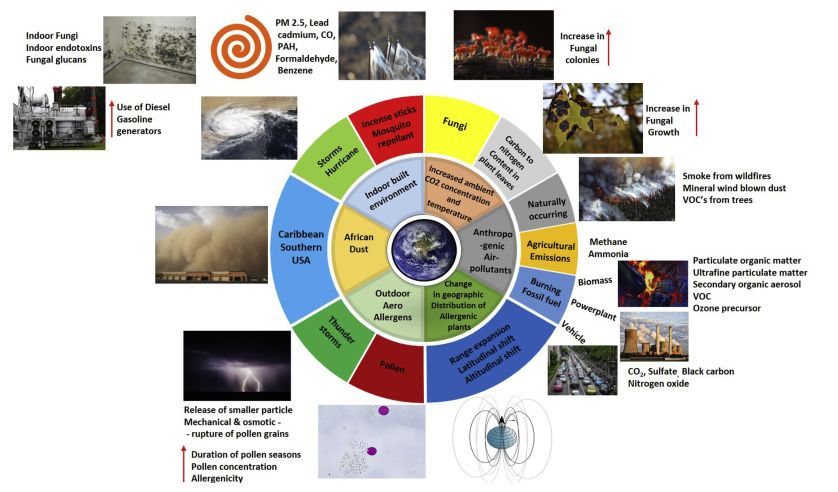JACI:天氣和氣候變化對哮喘患者的影響(AAAAI 工作報告)
發(fā)布日期:2019-06-26
原標(biāo)題:天氣和氣候變化對室內(nèi)外空氣質(zhì)量的改變對哮喘患者的影響(AAAAI 工作報告 )

延伸閱讀
JACI
DOI: org/10.1016/j.jaci.2019.02.018
Abstract:
Weather and climate change are constant and ever-changing processes that affect allergy and asthma. The purpose of this report is to provide information since the last climate change review with a focus on asthmatic disease. PubMed and Internet searches for topics included climate and weather change, air pollution, particulates, greenhouse gasses, traffic, insect habitat, and mitigation in addition to references contributed by the individual authors. Changes in patterns of outdoor aeroallergens caused by increasing temperatures and amounts of carbon dioxide in the atmosphere are major factors linked to increased duration of pollen seasons, increased pollen production, and possibly increased allergenicity of pollen. Indoor air pollution threats anticipated from climate changes include microbial and mold growth secondary to flooding, resulting in displacement of persons and need for respiratory protection of exposed workers. Air pollution from indoor burning of mosquito repellants is a potential anticipatory result of an increase in habitat regions. Air pollution from fossil fuel burning and traffic-related emissions can alter respiratory defense mechanisms and work synergistically with specific allergens to enhance immunogenicity to worsen asthma in susceptible subjects. Community efforts can significantly reduce air pollution, thereby reducing greenhouse gas emission and improving air quality. The allergist's approach to weather pattern changes should be integrated and anticipatory to protect at-risk patients.
First Author:
Jill A. Poole
Correspondence:
Nebraska Medical Center, Omaha, NE 68198.
All Authors:
Jill A. Poole, Charles S. Barnes, Jeffrey G. Demain, Jonathan A. Bernstein, Mahesh A. Padukudru, William J. Sheehan, Guillermo Guidos Fogelbach, James Wedner, Rosa Codina, Estelle Levetin, John R. Cohn, Steve Kagen, Jay M. Portnoy, Andre E.


——浙大迪迅 譯
天氣和氣候變化是一個持續(xù)變化的過程,影響過敏和哮喘。本報告旨在提供自上次氣候變化審查以來的信息,重點關(guān)注哮喘疾病。PubMed和互聯(lián)網(wǎng)搜索主題包括氣候和天氣變化、空氣污染、顆粒物、溫室氣體、交通、昆蟲棲息地和癥狀緩解,以及作者個人提供的參考資料。氣溫升高和大氣中二氧化碳含量增加引起的室外空氣過敏原模式變化是導(dǎo)致花粉季節(jié)持續(xù)時間延長、花粉產(chǎn)量增加和花粉過敏性可能增加的主要因素。預(yù)計氣候變化對室內(nèi)空氣污染的威脅包括洪水引發(fā)的微生物和霉菌生長,人員流離失所以及暴露工人呼吸保護(hù)的需要。室內(nèi)燃燒驅(qū)蚊劑造成的空氣污染是昆蟲棲息地區(qū)域增加的潛在預(yù)期結(jié)果?;剂先紵a(chǎn)生的空氣污染和與交通有關(guān)的排放會改變呼吸防御機制,并與特定的過敏原協(xié)同作用,增強免疫原性,使易感受試者的哮喘惡化。社區(qū)環(huán)保的努力可以顯著減少空氣污染,從而減少溫室氣體排放,改善空氣質(zhì)量。過敏癥專家應(yīng)對天氣模式變化的方法應(yīng)該是綜合的,并且是預(yù)期的,以保護(hù)高?;颊摺?br />

延伸閱讀
JACI
[IF:13.258]
Impact of weather and climate change with indoor and outdoor air quality in asthmatic patients DOI: org/10.1016/j.jaci.2019.02.018
Abstract:
Weather and climate change are constant and ever-changing processes that affect allergy and asthma. The purpose of this report is to provide information since the last climate change review with a focus on asthmatic disease. PubMed and Internet searches for topics included climate and weather change, air pollution, particulates, greenhouse gasses, traffic, insect habitat, and mitigation in addition to references contributed by the individual authors. Changes in patterns of outdoor aeroallergens caused by increasing temperatures and amounts of carbon dioxide in the atmosphere are major factors linked to increased duration of pollen seasons, increased pollen production, and possibly increased allergenicity of pollen. Indoor air pollution threats anticipated from climate changes include microbial and mold growth secondary to flooding, resulting in displacement of persons and need for respiratory protection of exposed workers. Air pollution from indoor burning of mosquito repellants is a potential anticipatory result of an increase in habitat regions. Air pollution from fossil fuel burning and traffic-related emissions can alter respiratory defense mechanisms and work synergistically with specific allergens to enhance immunogenicity to worsen asthma in susceptible subjects. Community efforts can significantly reduce air pollution, thereby reducing greenhouse gas emission and improving air quality. The allergist's approach to weather pattern changes should be integrated and anticipatory to protect at-risk patients.
First Author:
Jill A. Poole
Correspondence:
Nebraska Medical Center, Omaha, NE 68198.
All Authors:
Jill A. Poole, Charles S. Barnes, Jeffrey G. Demain, Jonathan A. Bernstein, Mahesh A. Padukudru, William J. Sheehan, Guillermo Guidos Fogelbach, James Wedner, Rosa Codina, Estelle Levetin, John R. Cohn, Steve Kagen, Jay M. Portnoy, Andre E.
2019-05-08 Article
創(chuàng)建過敏性疾病的科研、科普知識交流平臺,為過敏患者提供專業(yè)診斷、治療、預(yù)防的共享平臺。

 杭州浙大迪迅生物基因工程有限公司
杭州浙大迪迅生物基因工程有限公司

